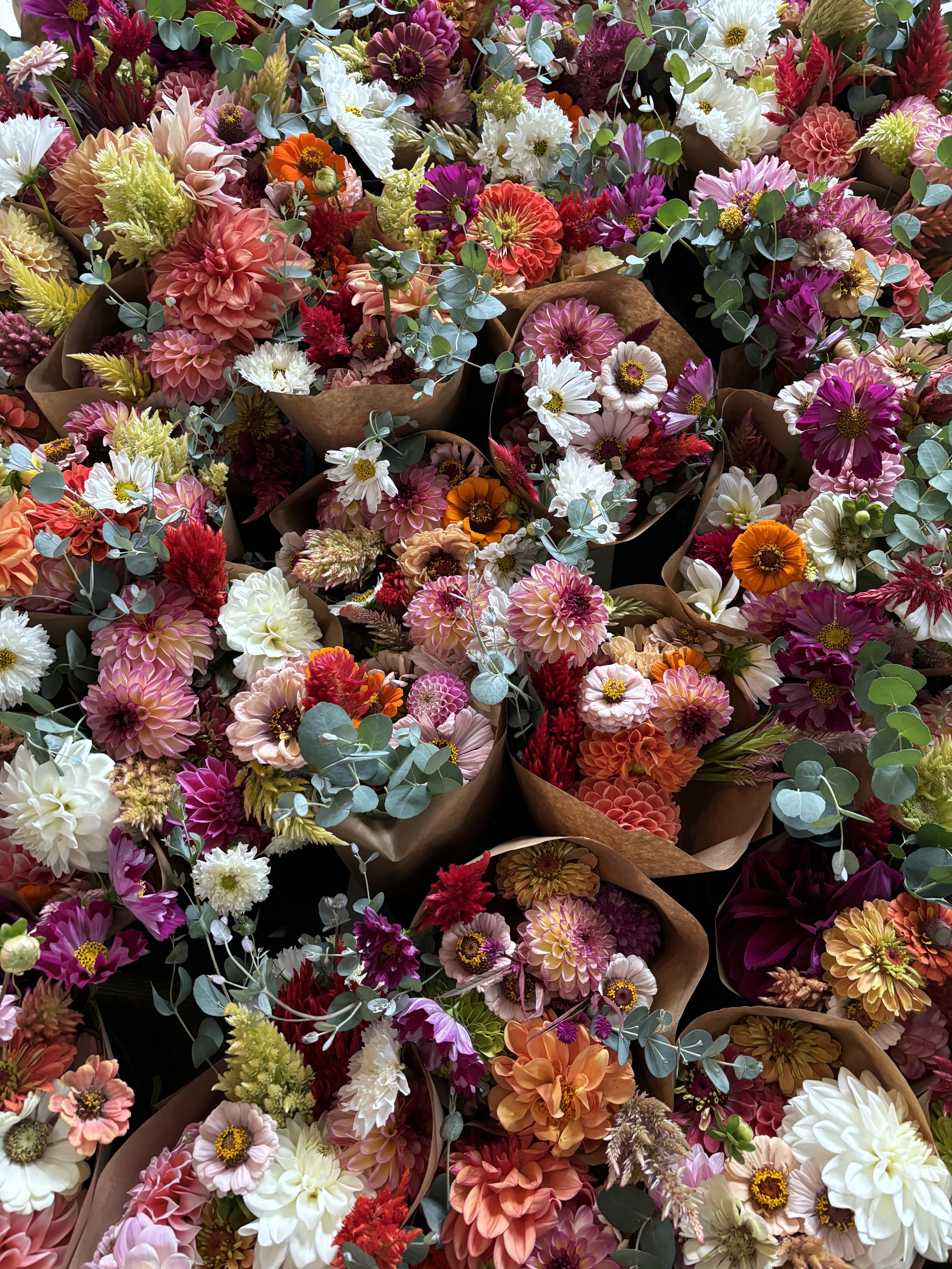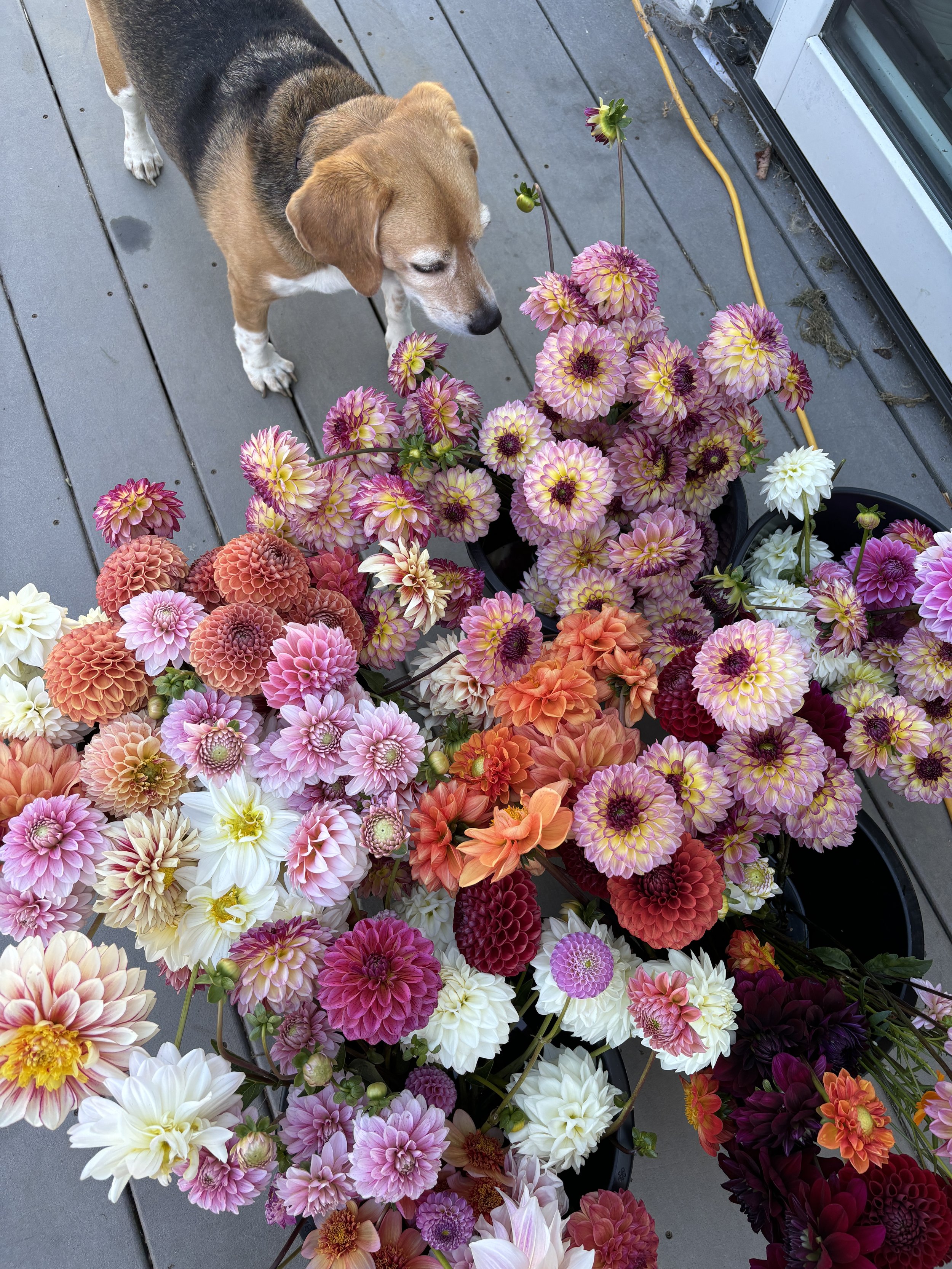Our 2025 Farm Plan
It’s that time of year again, my friends. The farm is quiet, buried under a couple feet of snow, but a lot has been happening behind the scenes. I’ve been having wedding inquiry calls and working on designs for the year, organizing our materials and work space, and, most importantly, business and crop planning for the season ahead!
This is a beast of a project and usually takes me a couple weeks to fully wrap my head around, starting with looking at last year's harvest records and notes, making any necessary adjustments based on what we learned and what we're projecting for this year, and then laying out where everything will go and when. It's a combination of spreadsheets, maps, written notes and research and it gets pretty technical, which always surprises people. It's one of the differences between growing flowers commercially and growing a garden for fun: gotta love looking at the numbers, or at least tolerate it in my case 😅) to analyze crop production and profit margins just as much as flipping through the pretty seed catalogues!
Here’s a look at what’s to come, and how I approach planning.
I start with financial projections for the season and our sales outlets. This is determined based on weddings and other events we have booked, learnings from last year and what we want to adjust for the year ahead based on capacity. This is an important place to start, because it guides what we grow and how much. I look at our wedding designs and which crops and colors that we’ll heavily rely on, as this bucket requires the bulk of our production. I also consider subscription numbers and what crops do well for those (they need to be longer lasting than wedding flowers and require efficient harvesting/post-harvest care) and rely on my notes from last year to determine what not only sold on the truck or people gravitated toward in workshops, but what contributed to better output and thus better margins. For example, stock is beautiful and useful, but since one plant produces just one stem, it simply takes up too much valuable space that I could utilize for something else that has a similar shape but produces multiple stems, like snapdragons or celosia.
Here are my projections for this season:
Weddings (including deposits for new bookings: 70%
Wholesale: 4% (this may grow depending on a few factors that are a bit up in the air right now)
Workshops: 10%
Flower truck: 7%
Retail (including subscriptions): 5%
Therapeutic horticulture programming: 4%
Once I have this finalized, I move on to crop planning. I review my harvest records from last year and what we used each week (sooo many spreadsheets), and combine that insight with some yield research (how many stems one plant can produce) to back into how many plants I’ll need of each variety. I then assess if we need to change anything based on schedule fluctuations or those projections I made.
Then the fun part: ordering seeds and plugs! Though I’ve become pretty strategic (and ruthless) on that front which makes it less fun. It’s so hard not to order every pretty thing I see, but prioritizing the health of the business is the most important thing and I stick to my spreadsheets. I know it will be a beautiful season even if I don’t get allllll the flowers. We do a combination of seeds and plugs, which is also strategic. We’ve learned certain things like lisianthus, eucalyptus and campanula perform so much better starting from plugs and while they’re are more expensive, it costs us a lot more in materials and labor (including our own) to start a lot of these plants from seed and then transplant them out. Meanwhile things like zinnias, cosmos and sunflowers are not only easy to start from seed, but we can direct seed later successions once it’s warmer. I embrace working smarter, not harder more each year.
Next I lay out our spaces for both the home garden and the farm. This is where a lot of math comes in, since plants require different spacing and where my brain starts to short circuit. Breaks and brainstorming with (ahem, complaining to) Robbie helps, who does his spreadsheet wizardry and gets me back on track. We account for multiple successions and any potential bed flipping that will happen (for example once ranunculus and anemone are done early summer, those beds will be flipped to zinnias and celosia that will go through fall).
This year we’ll have our same 10 beds at home (that will be flipped from tulips to summer annuals in May), and at the farm we have the high tunnel (70 x 30 ft) plus three additional field plots. All in it’s around 16,000 plants!
Now that the space is planned and once seeds arrive, the final piece is determining the seed starting schedule. This is fairly straightforward based on our last frost date and how long each plant takes to mature. For example, cosmo seeds can be started indoors 5-7 weeks before the last frost, which is around March 20th. I am a visual gal and like to note the date on each seed packet and whether we’ll be direct seeding or starting it indoors, so that I can organize the packets by date. We do also have digital spreadsheets outlining all this info so it’s easily accessible for other team members (mostly because Robbie insists on it 😂). We’re starting seeds pretty much every week from now through the end of May/early June.
And there you have it! There are always some bumps, and we know the best laid plans can get disrupted. But each year our planning process gets more efficient, which sets us up for a more successful season from the start.
I hope you’re looking forward to the flowers as much as I am, it’s going to be a beautiful season!
PS - we’re hiring for the upcoming season! If you or anyone you know could be a good fit for any of these open positions, please reach out to us at hi@nowadaysflowers.com. We’d love to hear from you.






